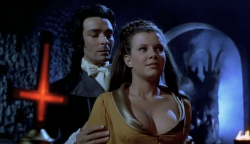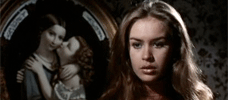Reviews
A Melodrama in Two Parts / Le Viol du la Vampire
Jean Rollin
France, 1968
Credits
Review by Thomas Scalzo
Posted on 14 February 2011
Source Image Entertainment DVD
Categories Lesbian Vampires
It may seem odd to kick off a week of lesbian vampire film reviews with this rather subdued feature film debut of erotic horror specialist Jean Rollin. After all, when compared with the other titles that will be covered this week, Rollin’s effort - though certainly featuring plenty of exposed breasts and scattered moments of undead amour - can only truly claim two or three scenes that can be classified as fitting the lesbian vampire mold. And truth be told, Rollin does not even devote entire scenes to this taboo subject matter, offering up little more than fleeting glimpses of vampiresses and the women they covet.
And yet, the fact that a mainstream French film from the late ’60s managed to include such elements at all is the reason why Rollin’s work is worth discussing in the context of the lesbian vampire film. He may not have explored all of the erotic potential of the lesbian vampire film in this, his first feature, but his work helped set the stage for the more explicit genre entries that appeared throughout the following decade. In fact, the trend toward more graphic depictions of sex in horror can be seen in Rollin’s film itself, moving as it does from a gothic tale with a smattering of nudity to an engrossing example of the erotic horror film.
This disparity is explained by the fact that, initially, Rape of the Vampire was conceived and shot as a short film. Owing to positive initial responses, additional - and more highly erotic - material was created and the film was subsequently expanded to feature length. However, instead of trying to integrate the new material with the old, it was decided to run Rollin’s original short as the first of a two part tale and follow it up with the additional footage. Thus the actual onscreen title is Rape of the Vampire: A Melodrama in Two Parts. Part one being The Rape of the Vampire, Rollin’s original gothic short, which works as a complete film on its own, and part two: The Vampire Women, an unpredictable and bizarre extension of the original story.
Though recounting plot points is often an exercise in futility when Jean Rollin is involved, it’s worth outlining the main points of each tale here in order to provide a context for the brief forays into lesbian vampirism. As has been mentioned, part one is Rollin’s original short film, a gothic nightmare in which the lines of truth and reality are deliberately and enjoyably blurred. The bulk of the tale takes place on an isolated and weed-choked estate, where four lovely but sad young ladies live out their days. Told from birth that they are vampires, and sisters, the girls spend their time sitting around a dining table sulking, and occasionally paying homage to a large goat-creature statue out in the yard. The lord of the manor, a lecherous old codger, seemingly wants nothing more out of life than to keep the girls in a constant state of fear, going so far as to erect wooden crosses all over the grounds and use every opportunity to reinforce the idea that they are in fact undead.
When an altruistic trio of city-dwellers arrives at the crumbling mansion in an effort to help the poor girls understand that they are not actually vampires, the lord is understandably upset. And so the battle of wits, words, and weapons begins, with each side convinced of the rightness of their cause. Though the story does grow a bit convoluted at times, the concept of vampirism as a state of mind, rather than a physical affliction, remains a central part of the story. That the viewer is time and again forced to rethink his opinion as to the true nature of these girls makes for an intriguing entry in vampire lore, one that George Romero would explore more fully in his fascinating film Martin.
Of course, this being a Jean Rollin film, such intriguing vampire concepts are deployed hand in hand with an appreciable amount of exposed female flesh. Though certainly not as explicit as his subsequent films, such regular reliance on female nudity must have turned a few heads in 1968. As is the often the case with Rollin, however, nudity is by no means always accompanied by a sexual scenario. One of his favorite tropes, for instance, which he makes repeated use of here, is to drape his lovely leading ladies in semi-transparent white robes and then light them from behind. The result, while beautiful, and somewhat erotic, can hardly be considered a sexual situation.
It was somewhat of a surprise, then, when part one’s only true lesbian vampire moment occurs. Mysteriously summoned to the dining room where the four ladies spend their time, the lone female member of city trio, Brigitte, walks straight up to one of the sisters and stands submissively before her. The supposed vampire proceeds to take off Brigitte’s shirt and begins fondling her breasts. The scene lasts but a few brief seconds, Brigitte’s male companions soon rushing in to save her, and no repeat of the incident occurs. There are some subtle hints that perhaps there is an attraction between these two women, but in terms of a significant subplot, there’s not much to go on. We can only assume, then, that Rollin was using such a scene to test the waters of what he could get away with. That part two of this film was commissioned, bringing with it more nudity, more explicitly sexual scenarios, and more overtly lesbian encounters, leads us to believe that someone liked what Rollin was doing.
Though picking up at the exact moment where part one left off, The Vampire Woman quickly establishes itself as a film entirely different from Rollin’s opening short. For starters, there is no question that the gang of female vampires here are definitely the undead. They have fangs, they drink blood, and they are led by an oft-topless vampire queen. Though they can seemingly exist in the sunlight, in all other respects they are vampires. As the confusing plot of part two develops, we learn that the ultimate goal of the vampire queen is to create an army of undead warriors to do her bidding. Standing in her way are some of the characters from part one, and a small group of scientists hoping to discover an antidote to vampirism. The subtle mysteries of part one are thus nowhere to be found, replaced instead by an elaborate power struggle between the queen and those who would get in her way.
Nevertheless, and despite the convoluted and overwrought plot, part two does offer up more of Rollin’s trademarks: a great gothic atmosphere of desolate fields, derelict mansions, and ominous sea cliffs; and several scenes of intense erotic imagery. As has been mentioned, part two also expands Rollin’s depiction of the lesbian vampire, with the queen in particular serving as a predecessor to various depictions of the Countess Bathory. From her penchant for biting the necks of young women, to her reservoir room featuring comatose and naked girls hooked up to blood-collecting devises, the queen certainly has a leaning toward the ladies. Though the actual scenes of her intimately interacting with another woman are few and brief, the lesbian vampire undertones are in evidence.
Though certainly suffering somewhat from an inconsistent tone from part one to part two, on the whole, Rape of the Vampire serves as an intriguing introduction to the bizarre cinematic world of Jean Rollin. As his first feature, we’re able to see him experimenting with the settings, lighting techniques, artistically erotic images, and frank sexual depictions that would come to define his work. And as a progenitor to the increasingly explicit lesbian vampire films to come, the film is an interesting study of a director discovering how far he can push the limits of what is acceptable to show on screen, all the while striving to maintain an aura of gothic, haunting beauty.
More Lesbian Vampires
-

Rape of the Vampire
1968 -

The Vampire Lovers
1970 -

Lust for a Vampire
1971 -

Twins of Evil
1971 -

Vampyros Lesbos
1971 -

Daughters of Darkness
1971 -

The Blood Spattered Bride
1972 -

Vampyres
1974
We don’t do comments anymore, but you may contact us here or find us on Twitter or Facebook.



